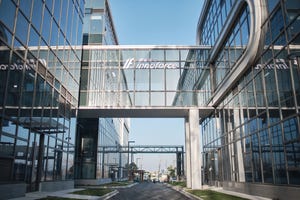
The cell-free and enzymatic nature of its mRNA technology has allowed Moderna to quickly build a relatively small network capable of supporting commercial manufacture of its COVID-19 vaccine.
On Monday, President Trump named Pfizer and J&J as leading the way in bringing a coronavirus vaccine to market. But also speaking Monday, Tal Zaks, chief medical officer at Moderna Therapeutics, believes it will be his firm that will be the first to bring both a vaccine to market and “to deliver on the promise of our mRNA science.”
Zaks was speaking as part of Xconomy’s Xcelerate Series at Biotech Week Boston. His firm was quick off the mark in developing a COVID-19, taking up the task on January 13 just two days after the genomic sequence of isolated SARS-CoV-2 was released to public databases. With the candidate mRNA-1273 in late-stage trials, approval is potentially weeks away.

Moderna CMO Tal Zaks spoke Monday at the Xconomy Xcelerate event
To prepare for this, Moderna has been building up its manufacturing network with an aim to produce up to 1 billion doses of the vaccine in 2021. However, unlike other vaccine makers in the COVID game, Moderna has a relatively small network comprising of its own site in Norwood, Massachusetts – offering plasmid, buffer prep, QC and sterile filling capacity – and third-party capabilities from Lonza, Catalent and Laboratorios Farmacéuticos Rovi.
“One of the beauties of our platform is that actually, the scale of production is quite small because our manufacturing is cell-free, it is really an aqueous phase enzymatic reaction,” he told delegates.
“Traditional biotechnology requires these massive bioreactors, because there’s a limited space into which you can crowd cells before they get really, really unhappy. But enzymatic reactions actually like to be dense – in fact, they become more efficient.”
mRNA, or ‘messenger RNA, is made in the nucleus using the nucleotide sequence of DNA as a template. The process involves using nucleotide triphosphates as substrates catalyzed by the enzyme RNA polymerase II. The mRNA formed is transported out of the nucleus and into the cytoplasm where it instructs proteins to assemble on the ribosomes using the mRNA nucleotide sequence.
“If you understand the fact that it’s a simple enzymatic process at the end, and the scale is relatively small, it explains why we’ve been able to both start our trial so fast,” he continued. It took just a couple of months from sequence design to a subject dosed, he added.
“It also explains why we’ve been able, in a relatively fast turnaround time, to start up a manufacturing footprint that is now global, both in the US and in Switzerland from scratch. We’ve been planning for it now for a number of years, because of our other vaccines. But we’ve been able to move really, really quickly because of the underlying power of this technology.”
About the Author
You May Also Like

schedl_b_and_w.jpg?width=100&auto=webp&quality=80&disable=upscale)
schedl_b_and_w.jpg?width=400&auto=webp&quality=80&disable=upscale)






